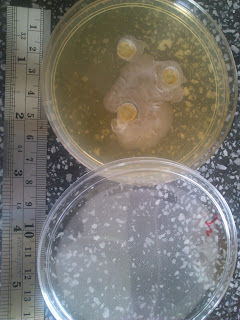The result that came out isn't as expected--an inhibition zone is shown all right; but it is not a clear zone. Rather, it seems very opaque. As follows.
So, after much pondering, possible explanation is as follows:
1) the sample really spread outside the well, creating an inhibition zone.
2) that wasn't the sample, it was a living, growing microbe.
therefore, this hypothesis is put to the test by taking a bit from the "inhibition zone" and streaking it on a new plate:
A growth of similar shape and color occurs, which tells me this is a microbe. So the (2) reason is accepted.
Then, looking deeper, the second reason has two possible outcomes, that is:
a) the sample is contaminated from somewhere else.
b) the sample has it's own microbe that has inhibitory properties.
So, to test this, is to take a swab of the original sample straight from the bottles, for every batch.
The swab is streaked on a nutrient agar and left for 18 hours. If not all the sample shows the growth, (a) is true. But if every batch shows the same microbe, (b) is true.
The result is shown as below:
Well, only one sample plate shown to have the microbe--the 6th March sample used in the agar-well test. Therefore, it is proven that this is a one-off contamination and not a special microbe.
Another thing to add--during the agar well test though, in some other plates, the growth inhibition effect does not show. it can be explained, since probably the microbe in the sample is unable to inhibit the culture's microbes.
So in conclusion, one of the sample was contaminated with a microbe that is selectively inhibiting. May be useful, maybe not. We'll see.
I guess that is how a student's mind should work eh. Later guys :)







No comments:
Post a Comment